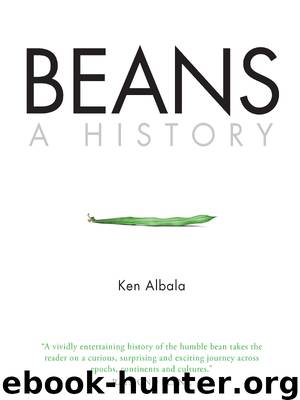Beans by Ken Albala

Author:Ken Albala
Language: eng
Format: epub
Publisher: Berg Publishers
Published: 2010-11-30T16:00:00+00:00
9
Phaseolus vulgaris: Mexico and the World
Think of the epitome of bean, the bean that embodies absolute beanity and it will almost certainly be a variety of the single species, Phaseolus vulgaris, the common bean. This species has done a better job than perhaps any other plant at insinuating itself around the globe in the place of traditional indigenous species. Moreover, these beans come in so many shapes and colors, are so infinitely adaptable and versatile that we rarely think of them as manifestations of a single ancestral progenitor. In many respects, Phaseolus is most like our own species – spread around the globe in every imaginable climate. The white navy bean, mottled pinto bean, red kidney bean, black bean, green flageolet, as well as fresh green beans or string beans, haricots and so forth are all the same species. They are all quite different characters too, some homespun and honest, others rugged as the untamed West, others boisterous and flamboyant.
To understand these beans we must begin with their origins in the Americas. The wild ancestor of Phaseolus is spread from Northern Mexico to Argentina and it was domesticated independently both in the Peruvian Andes, from the aborigineus sub-species as well as in Mexico from the mexicanus sub-species. In the course of millions of years in the wild and several thousand more in cultivation, their forms diverged significantly and when crossed today they produce mostly infertile hybrids, which is decent evidence of independent domestication. The changes experienced through human interaction and selection constitute what is called the “domestication syndrome.” This involves developing pods that will not shatter and disperse seeds, seed dormancy which allows them to be stored for later use as food or to plant, tolerance of differing light conditions which allows them to be grown at different latitudes and locales outside of the tropics where days are relatively short, and development of sturdy stalks whose beans mature all at once and can be harvested at the same time rather than trailing vines which mature irregularly. This may have been the result of selecting vines which grow up corn stalks. Lastly, there is the amazing variation in size and color. All these are the result of human intervention.
Exactly when these events took place is more difficult to determine, partly because archaeological remains are sparse in the humid environment of Mesoamerica, unlike the dry Fertile Crescent of Southwest Asia. Remains of P. vulgaris from a cave in the Peruvian Andes have been radiocarbon dated at about 6000 BCE and they may have been domesticated well before that, perhaps contemporaneous with or even before Old World beans. Their domestication, again independently, occurred in Mexico only a few thousand years later, if the surviving archaeological remains can be trusted. Carbon 14 dating has proven fairly erratic and is being called into question with newer Atomic Mass Spectrometry methods, so it is probably safest to say that these beans were domesticated several thousand years ago, without indicating a precise chronology.
Beans were one of the principal crops among early New World civilizations.
Download
This site does not store any files on its server. We only index and link to content provided by other sites. Please contact the content providers to delete copyright contents if any and email us, we'll remove relevant links or contents immediately.
| Culinary Biographies | Essays |
| Food Industry | History |
| Reference |
A Court of Wings and Ruin by Sarah J. Maas(7618)
The Death of the Heart by Elizabeth Bowen(3530)
The Sprouting Book by Ann Wigmore(3529)
Better Homes and Gardens New Cookbook by Better Homes & Gardens(3508)
BraveTart by Stella Parks(3381)
Salt, Fat, Acid, Heat: Mastering the Elements of Good Cooking by Nosrat Samin(3094)
Sauces by James Peterson(3033)
Kitchen confidential by Anthony Bourdain(2989)
The Bread Bible by Rose Levy Beranbaum(2987)
Classic by Mary Berry(2929)
Solo Food by Janneke Vreugdenhil(2912)
Ottolenghi - The Cookbook by Yotam Ottolenghi(2854)
Martha Stewart's Baking Handbook by Martha Stewart(2783)
Day by Elie Wiesel(2704)
Betty Crocker's Good and Easy Cook Book by Betty Crocker(2670)
The Plant Paradox by Dr. Steven R. Gundry M.D(2527)
My Pantry by Alice Waters(2526)
The Kitchen Counter Cooking School by Kathleen Flinn(2474)
Hot Sauce Nation by Denver Nicks(2439)
